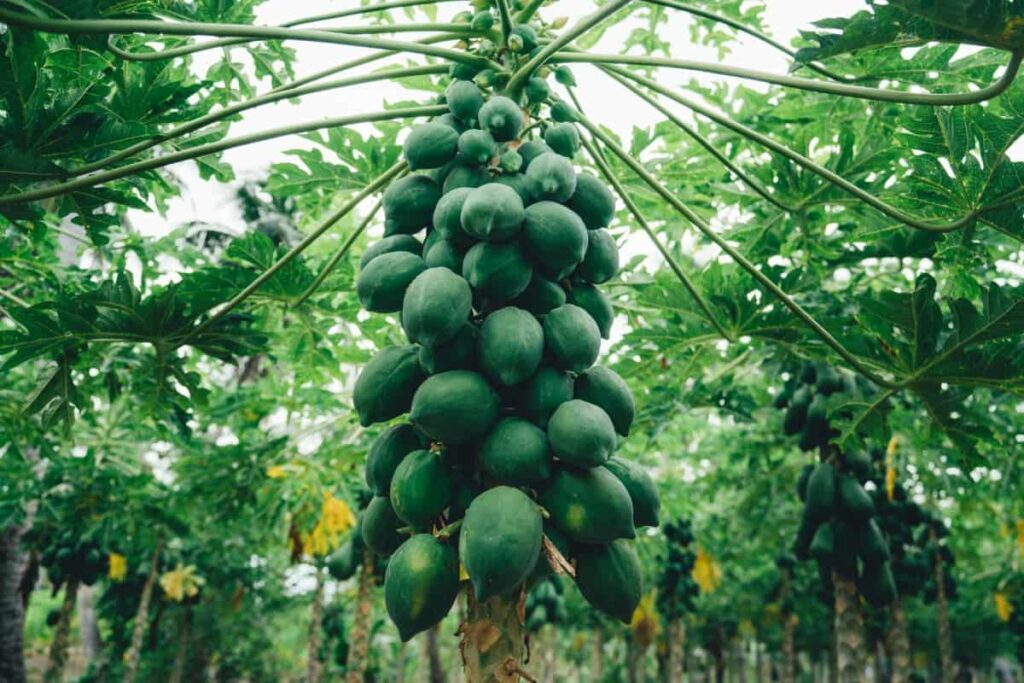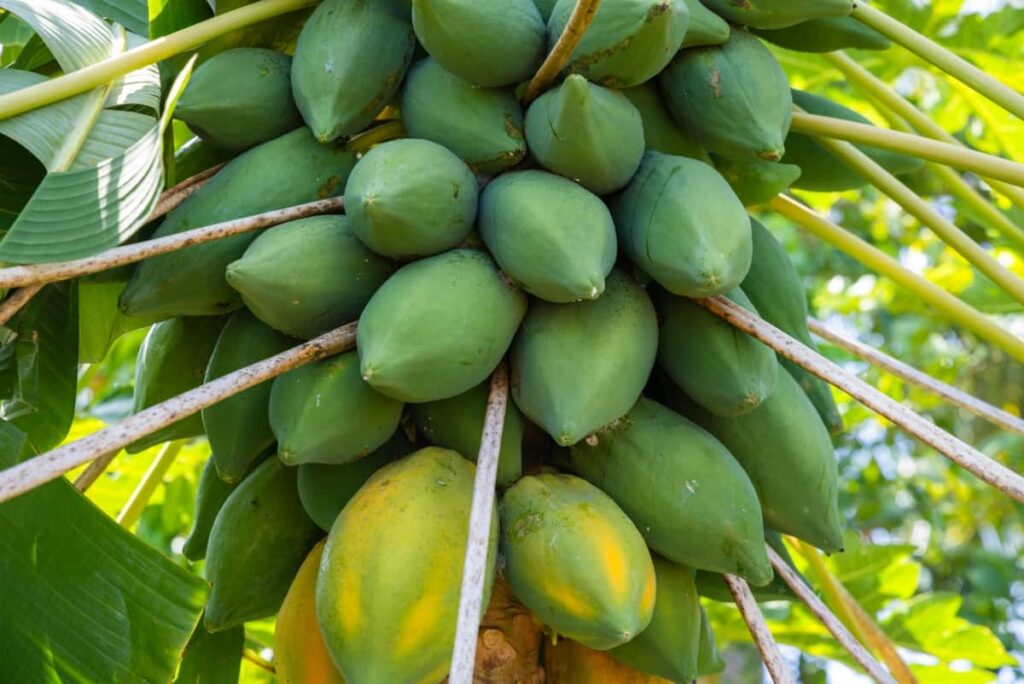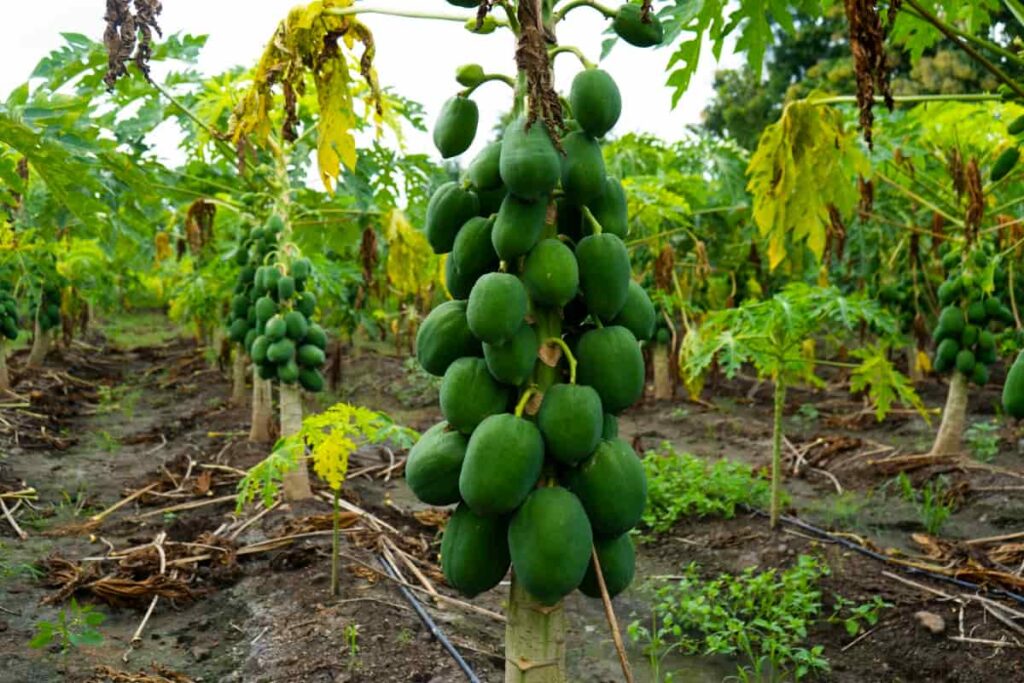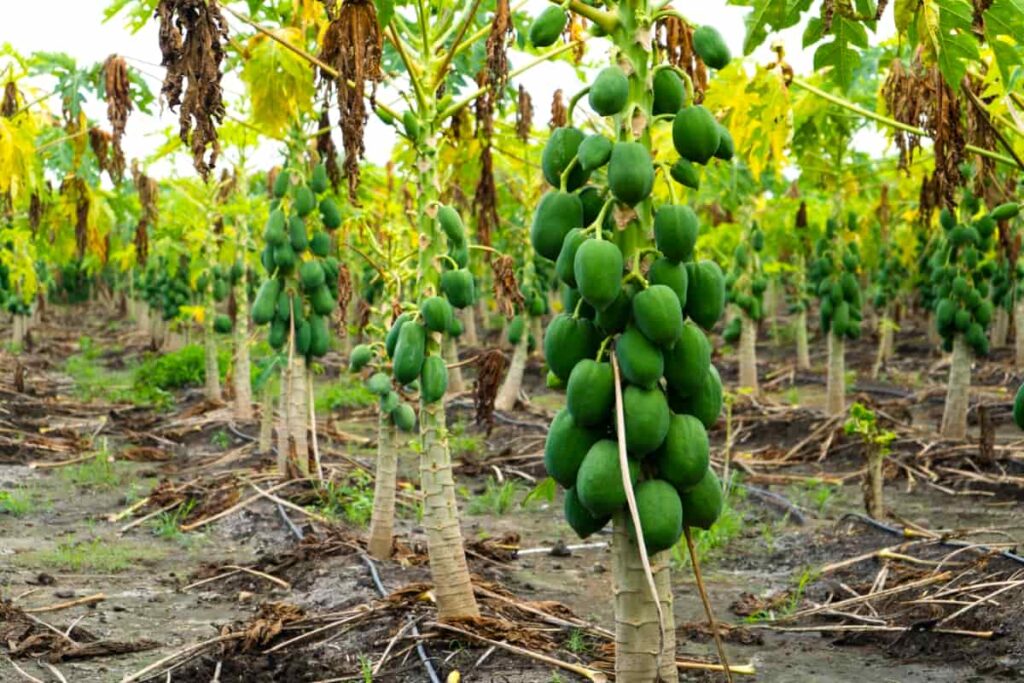Papaya (Carica Papaya) is a succulent fruit of a large plant of the family Caricaceae. These tropical fruit trees are known for their fast growth rate and ability to bear fruit within a year under optimal conditions. Papaya farming plays a crucial role in providing fresh and nutritious fruit to consumers worldwide.

Understanding Papaya Flower Biology
Papaya flowers are more than just beautiful blooms adorning the trees; they play a crucial role in the fruit production process. Understanding Papaya flower biology is key to successful farming. These delicate flowers are unique, with distinct characteristics that influence pollination and fruit development. Adequate sunlight, proper nutrition, and consistent watering are essential conditions for flowering. Without these essential factors, Papaya plants may struggle to produce healthy blossoms, leading to decreased fruit yield.
Types of Papaya Flowers: Hermaphrodite, Male, and Female
Papaya plants have three types of flowers: hermaphrodite, male, and female. Each type plays a crucial role in the pollination process and, ultimately, fruit production.
- Hermaphrodite flowers are the most common in Papaya farming. These flowers contain both male stamens for pollen production and female pistils for receiving pollen, allowing them to self-pollinate or cross-pollinate with other plants.
- Male flowers only produce pollen and do not have a pistil for fruit development. Their main function is to provide pollen for fertilizing the female flowers, ensuring successful pollination and fruit set.
- Female flowers possess only a pistil designed to receive pollen from either self-pollination or cross-pollination by bees or other pollinators. Once fertilized, these flowers develop into delicious Papayas ready for harvest.
Optimal Conditions for Flowering
Papayas thrive in warm climates with plenty of sunlight, so it’s essential to plant them in well-draining soil that receives adequate sunshine throughout the day. Maintaining consistent moisture levels is key to promoting healthy flower development. Overwatering the Papaya can lead to root rot while underwatering can stress the Papaya plants and hinder flower production. Finding the right water balance is essential for success.
In case you missed it: Leaf Curl Virus Treatment in Papaya: How to Manage with Organic, Natural, and Chemical Control

Furthermore, providing regular fertilization tailored to Papaya’s specific nutrient needs can help support vigorous growth and abundant flowering. Paying attention to these details will encourage your Papaya plants to bloom profusely and set fruit effectively.
Pollination Mechanisms in Papaya
Papaya plants have three types of flowers: hermaphrodite, male, and female. Hermaphrodite flowers have male and female parts, making them self-pollinating. However, cross-pollination can enhance yield and quality. Papayas rely on wind and insects for pollination. Bees are primary pollinators attracted to the plant’s nectar-rich flowers. Their buzzing activity helps transfer pollen between flowers, facilitating fertilization.
While natural pollination by bees is effective, some farmers opt for manual methods to ensure thorough pollen dispersal. Hand pollination involves transferring pollen from male to female flowers using a brush or cotton swab carefully. Understanding the mechanisms of Papaya pollination is essential for maximizing crop productivity and quality.
The Role of Pollinators in Papaya Orchards
Pollinators play a crucial role in Papaya orchards by facilitating the pollination process, which is essential for fruit production. These diligent creatures, ranging from bees to butterflies and birds, diligently transfer pollen from one flower to another. As they go about their daily routines, they unknowingly aid in the process of fertilization. The buzzing wings of bees carry pollen grains from male flowers to female ones, kickstarting the development of juicy Papayas we all love.
Butterflies gracefully flutter around, contributing their share to this intricate dance of nature. Birds also play a part in this ecosystem by inadvertently assisting with pollination as they move between flowers, seeking nectar. Efforts to support pollinators in Papaya orchards include providing suitable habitat, minimizing the use of pesticides harmful to pollinators, and ensuring a diverse floral resource base to support pollinator populations throughout the growing season.
Manual vs. Natural Pollination Techniques
Manual pollination involves hand-pollinating each flower individually, ensuring precise fertilization and fruit set. This method can be labor-intensive but allows for control over the process. On the other hand, natural pollination relies on insects like bees and wind to transfer pollen between flowers.
In case you missed it: Best Fertilizer for Red Lady Papaya: Schedule of Organic, Liquid, Natural, Homemade, NPK Fertilizers

While this method is less laborious, it is subject to environmental factors that may impact pollination success rates. Farmers often choose a combination of both methods based on their resources and specific needs to optimize fruit production in Papaya orchards.
Influencing Factors on Pollination Success
Weather conditions can greatly influence pollinator activity. Adequate sunlight exposure is also essential for promoting flower development and attracting pollinators to the orchard. The presence of diverse plant species nearby can enhance biodiversity and attract different types of pollinators to the Papaya farm.
Proper soil health and nutrient levels are important for supporting robust plant growth and flower production. Additionally, managing pests and diseases effectively can help maintain a good environment for both plants and pollinators. Avoiding the use of harmful chemicals that may deter or harm beneficial insects is key to ensuring successful pollination in Papaya orchards.
Common Issues in Flowering and Pollination
There are common issues that farmers may encounter along the way. One of these issues is inconsistent weather patterns, which can disrupt the natural pollination process. Another challenge is pest infestations, as insects can disturb flowers and hinder successful pollination.
Furthermore, nutrient deficiencies in the soil can impact flower development and overall plant health. Improper pruning techniques or neglecting proper care practices can also lead to poor flowering outcomes. Additionally, overcrowding within orchards can limit airflow and sunlight exposure, affecting flower production.
Management Practices to Enhance Pollination
To improve pollination, consider planting diverse flowering plants nearby to attract more pollinators. Creating a good environment for bees, butterflies, and other insects can significantly increase the chances of successful pollination. Additionally, implementing proper irrigation practices to ensure consistent moisture levels in the soil can help support healthy flower development.
In case you missed it: Papaya Farming Information Guide

Avoiding over-fertilization and using organic fertilizers can also promote better blooming and fruit setting. Furthermore, maintaining optimal spacing between Papaya trees allows for adequate airflow and sunlight penetration, which are essential for promoting flower production.
Monitoring and Assessing Flower and Fruit Development
Once the flowers have bloomed in your Papaya orchard, it’s crucial to monitor and assess their development closely. Keep a keen eye on how the fruits are forming and growing. Check for pests or disease signs that could potentially harm your crop. Observing the color, size, and shape of both the flowers and fruits can provide valuable insights into their health and maturity.
Make sure to track the progression of flower-to-fruit transformation over time. Remember, paying attention to detail during this stage of Papaya farming can significantly impact the quality and quantity of your final harvest. By employing proper management practices and staying attentive to the needs of the Papaya plants throughout their growth cycle, farmers can maximize their harvests.
- Profitable Village Farming Business Ideas in 2024
- High-Yield Aquaculture: Fast-Growing Fish for Farming
- Effective Fish Pond Construction Techniques for Beginners
- Irrigation and Water Management in Pineapple Farming
- Blossom to Harvest: Mastering Flowering and Pollination in Papaya Farming
- Pig Fattening Essentials: From Selection to Sale for Beginners
- Raising Wagyu Cattle: A Complete Guide for Premium Beef Production
- Soil Types and Their Water Holding Capacity
- Optimizing Irrigation Schedules for Coconut Groves for Enhanced Yield
